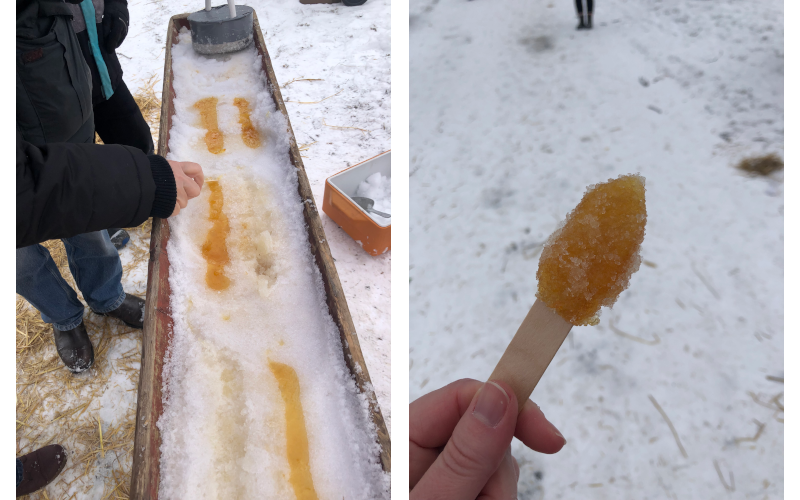March is sugar time in Québec (ironically, March is also Nutrition Month). It’s a loosely defined period between late February and early April that corresponds to the thaw and circulation of sweet sap in sugar maples (Acer saccharum). The harvesting of sap, or sweet water, its transformation into syrup and its use in cooking are traditions of the first peoples of Canada.
Today, it’s a time when people gather with family and friends to visit a sugar shack, where they can eat fatty, calorie-laden “traditional” foods like pea soup, maple-smoked ham, omelettes, cretons, baked beans, oreilles de crisse, sugar pie, pancakes, pouding chômeur, as well as the famous maple taffy on snow. Taffy is made from maple sap, which is boiled to a consistency thicker than syrup. This mixture is then poured over snow to harden. A wooden stick is used to pick up and roll up the hardened taffy for eating.

Maple syrup production is a major industry in Québec, worth hundreds of millions of dollars. In fact, an episode of the Netflix series Dirty Money describes the theft of $18 million worth of maple syrup between 2011 and 2012.
Barring a climatic calamity, it’s unlikely that you’ll be able to enjoy delicious maple taffy on snow when you come to Montréal in September. You will, however, find a variety of maple products in farmers’ markets, grocery stores and souvenir shops. The latter generally charge much more for smaller quantities of products. However, they may be the only ones to keep certain products in-stock year-round. In grocery stores, you’ll be able to buy several products at low prices to take home (please check with your government what you can bring back from a foreign country before buying anything):
- Maple syrup: sold in 540 ml cans for about $10. In grocery stores, you’ll find it in the “breakfast foods” section with jams and spreads. Be careful not to buy “table syrup” or simply “syrup”, which is not maple syrup. Unless you’re looking for a decorative bottle, canned syrup has much better value for the price.
- Maple leaf cookies: a maple cream between two maple leaf-shaped cookies. In grocery stores, you’ll find them in the cookies and snacks section. You’ll get a 350 g box for around $3 to $5.
- Maple spread: this can be maple caramel, maple butter, maple apple butter, etc. You’ll find these spreads in the “breakfast foods” section of grocery stores. Prices vary from product to product, but they generally cost between $3 and $4 per 100 ml.
- Maple beer, wine, and spirits: breweries, distilleries, and wineries are very creative in the use of maple in their products. Grocery stores and dépanneurs sell beer and wine, but you’ll only find uncommon beers in specialized stores (such as La Maison des Bières, or Veux-tu une bière). As for wine and spirits, you will find them at SAQ stores. Beers run from 5$ to 15$, wines start at 15$ and go up to several hundred dollars (as wine does), and spirits can go from 30$ to 70$ per bottle.
*Prices given are current grocery store prices. Given rapid inflation, prices may have risen by September.
Maple is ubiquitous in restaurants and grocery stores during the sugaring off season, and many menus offer a maple variant year-round. While you’re in Montréal, you will be able to sample some maple products and other sugar shack food in restaurants.
La binerie du Mont-Royal
Here, you can try baked beans, smoked ham, and cretons, among other things. It’s a tiny restaurant with limited seating. You can order takeaway or reserve in advance.
La beignerie
A tiny doughnut counter, one of whose flavours is maple and walnut. Take the opportunity to walk around rue Saint-Denis.
Qwelli
Most creameries have a maple flavor on their menu year-round. Qwelli sells delicious gelatos. They have some forty flavours, one of which is maple.
St-Hubert
The rotisserie chain, well known to the Québec public for its advertising jingle, offers a good sugar pie on its dessert menu.
For those of you in the community who live in Québec or in other maple-growing regions, we wish you a delicious sugar season and a mild spring.
